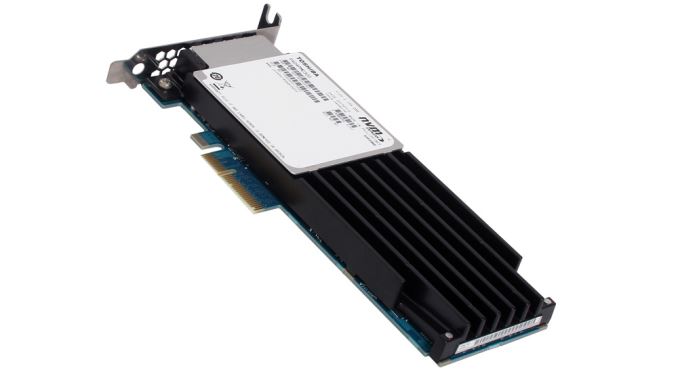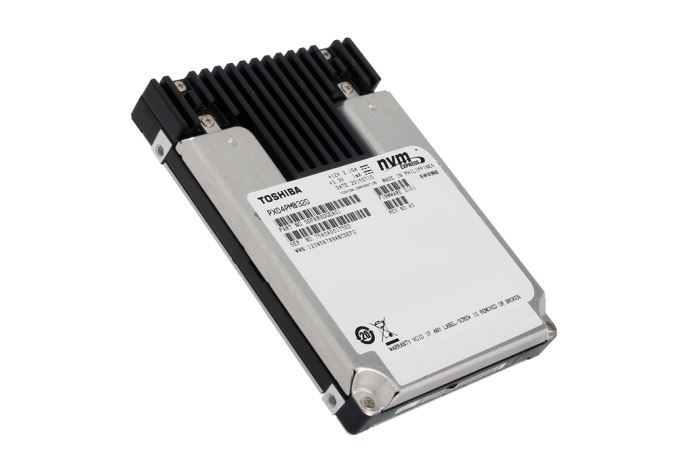Toshiba Announces Three New NVMe SSD Families
by Billy Tallis on August 11, 2015 2:00 AM EST- Posted in
- SSDs
- Toshiba
- SATA Express
- Enterprise SSDs
- M.2
- U.2

On the eve of Flash Memory Summit (August 11-13), Toshiba has announced a full range of NVMe-based PCIe SSDs using Toshiba controllers and Toshiba MLC flash.
| Toshiba NVMe Drive Families | |||
| Drive Series | PX04P | XG3 | BG1 |
| Form Factors and Interface | PCIe 3.0 x4 HHHL / 2.5” U.2 |
PCIe 3.1 x4 M.2 2280 / 2.5” SATA Express | M.2 2230 / 16mm*20mm soldered module "M.2 1620" |
| Capacities | 800 GB, 1600 GB, 3200 GB | Up to 1024GB | Up to 256 GB |
| QSBC Error Correction | Yes | Yes | No |
| TCG Pyrite Security | No | Yes | Yes |
| Sequential Read | 3100 MB/s | ? | ? |
| Sequential Write | 2350 MB/s | ? | ? |
| 4kB Random Read IOPS | 660k | ? | ? |
| 4kB Random Write IOPS | 185k | ? | ? |
For the enterprise market, the PX04P series complements the SAS-based PX04S drives announced last week. The PX04P is available as a 2.5” drive with a U.2 (SFF-8639) connector, or as a PCIe expansion card. In either case, the drive supports four lanes of PCIe 3.0 and can make good use of that bandwidth to offer up to 3.1 GB/s sequential read speeds. With an endurance rating of 10 drive writes per day it is intended for relatively write-heavy workloads.
For the high-performance client market, the XG3 is available in the M.2 2280 form factor using four lanes of PCIe 3.1, or as a 2.5” drive using the two-lane SATA Express connector. If these drives make it in to the retail channel, it means that consumers whose motherboards have a SATA Express connector but no M.2 slot will finally have an easy way to get in on the PCIe storage revolution.
For tablets and ultra-thin laptops, the BG1 is optimized for low power in very small packages. It comes as either an M.2 2230 card or a soldered-down module measuring 16mm by 20mm. The BG1's maximum capacity is only 256 GB, and given the power and size constraints it is probably not using a 4-lane PCIe connection.
The two client drive families implement support for the Trusted Computing Group Pyrite standard, a subset of TCG Opal that includes features necessary for things like secure boot but does not include encryption.
Source: Toshiba











17 Comments
View All Comments
Ian Cutress - Tuesday, August 11, 2015 - link
Most likely this announcement is to allow the big system integrators (Dell/Supermicro) to start planning product roadmaps. Then when they get sufficient orders, Toshiba might suggest a final MSRP, but that'll be substantially different to the thousands of units pricing that the SIs get. If it gets sold as individual units down the road, that will be after the SIs put their initial orders in, and then an MSRP might be made public. For some of these customers though, money is almost no object.plopke - Tuesday, August 11, 2015 - link
i sometimes kinda like these kind of articles , they can give a indication on how the OEM side is evolving. Which means getting a glimps on what the big manufactures are massproducing and what we might expect to see in consumer-end products. Like when M.2 is going to be mainstream etc ...freeskier93 - Tuesday, August 11, 2015 - link
So is Toshiba officially the first to have a SATA Express drive on the market?RealBeast - Tuesday, August 11, 2015 - link
Hardly, the Intel 750 is in stock at Newegg Business.freeskier93 - Tuesday, August 11, 2015 - link
The Intel 750 2.5" drive is U.2 not Sata Express.RealBeast - Wednesday, August 12, 2015 - link
Semantics: http://www.anandtech.com/show/9363/sff8639-connect...freeskier93 - Wednesday, August 12, 2015 - link
Hmmm, I had to do a bit more research and the differences between Sata Express and U.2 are ambiguous at best. Sata Express uses 2 PCIe lanes where U.2 uses 4. Looks like Sata Express is partially backwards compatible with U.2 if the right connector is used. I don't think U.2 is backwards compatible though with SATA Express since it requires 2 more PCIe lanes.